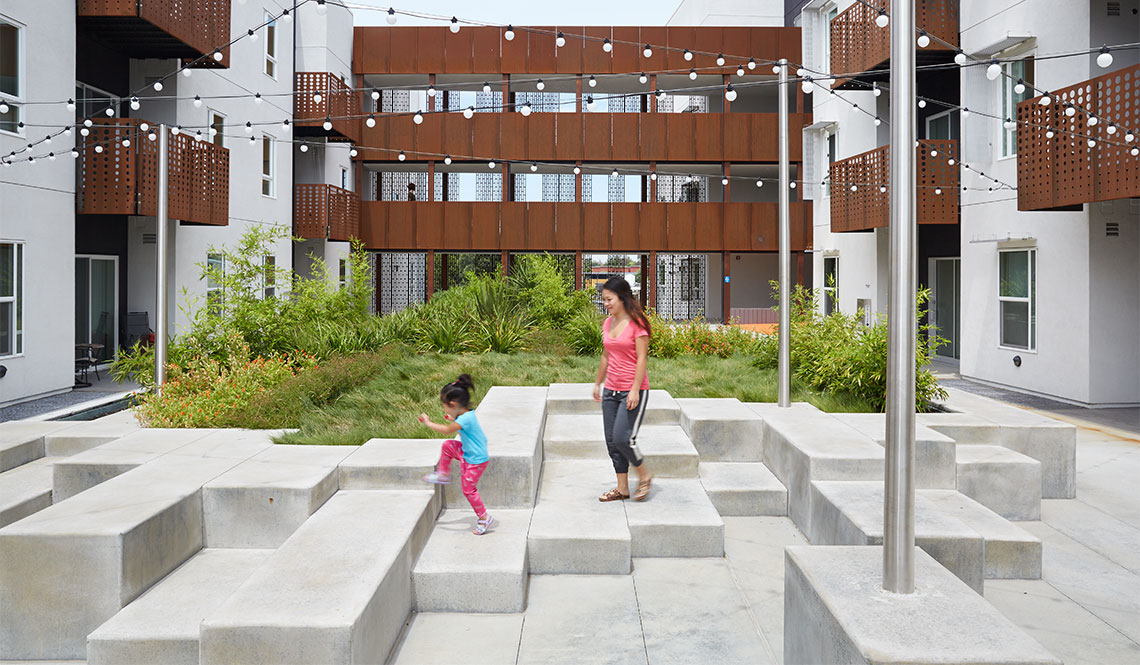Putting Housing Affordability First
- Select a language for the TTS:
- UK English Female
- UK English Male
- US English Female
- US English Male
- Australian Female
- Australian Male
- Language selected: (auto detect) - EN

Play all audios:

Facebook Twitter
"In most places, affordable housing is an afterthought. We build the places that we want to live in, and then, oh, because there’s some regulation, the city builds an afordable housing
project. That's not our philosophy here, particularly in the new areas that we've been creating along the waterfront, which has the potential to turn into a very exclusive, wealthy enclave
since it's so beautiful and has so many amenities around it."
— Chris Cabaldon, Mayor, West Sacramento, California
When the time came to develop West Sacramento's riverfront area, one of the first structures to rise was The Rivermark, a 70-unit apartment building developed by BRIDGE Housing, a nonprofit
with a mission to strengthen communities by "developing, owning and managing high-quality, affordable homes for working families and seniors." When the building opened in 2015, rents ranged
from $400 to $900 per month.
Constructing the building at the start of the development process rather than the end was a very conscious choice, explains Chris Cabaldon, West Sacramento's mayor of more than two decades.
"We need to, from the very beginning, declare that the area is going to be a mixed-income community, with all kinds of people living in it," he told AARP. "So let's start with the affordable
housing."
Situated on a disused industrial lot in West Sacramento’s developing 188-acre Bridge District, the Rivermark, designed by David Baker Architects, features affordable family-and age-friendly apartments near the riverfront and downtown Sacramento. Photo by Mariko Reed/OTTO
Another norm West Sacramento proudly debunks is that older people want to live among themselves in quiet, isolated places. "As we're aging, what we want are more opportunities for
engagement," says Cabaldon. "We want to spend less time in our cars. We don't want to be isolated. It doesn’t mean I want to live on top of a dance club, or that as a senior I want to
experience everything urban life has to offer. There are nuances to it."
Those nuances and differences are helping shape the city of 50,000.
"We've tried to create a city, even though we're small, where there's a place that matches what a person's needs are, and where their hopes and inspirations are at each stage in their life,"
says Cabaldon. "Now it's not about staying in the same place from the time you're 18 until you're 80. It is about being able to stay in the same community. One of our big hopes out of this
process is to make real that promise."
This article is adapted from the "Housing" chapter of the AARP book Where We Live: Communities for All Ages — 100+ Inspiring Ideas From America’s Community Leaders.
Reporting by Christina Clem | Page published November 2017
More from AARP.org/Livable
Use the dropdown to choose a livability topic.
Select a Subject Select a Subject AARP.org/Livable Home Page AARP Age-Friendly Network AARP Community Challenge AARP Livable Communities Newsletter AARP Livable Map Bicycling Community
Engagement Community Health and Wellness Community Resilience Community Diversity Economic Development High-Speed Internet Access Housing Inspiring Examples Livable Lessons Local Solutions
Placemaking Public Places and Outdoor Spaces Rural Livability Social Participation Surveys and Statistics Transportation Walkability Workshops and Conferences Zoning and Land Use